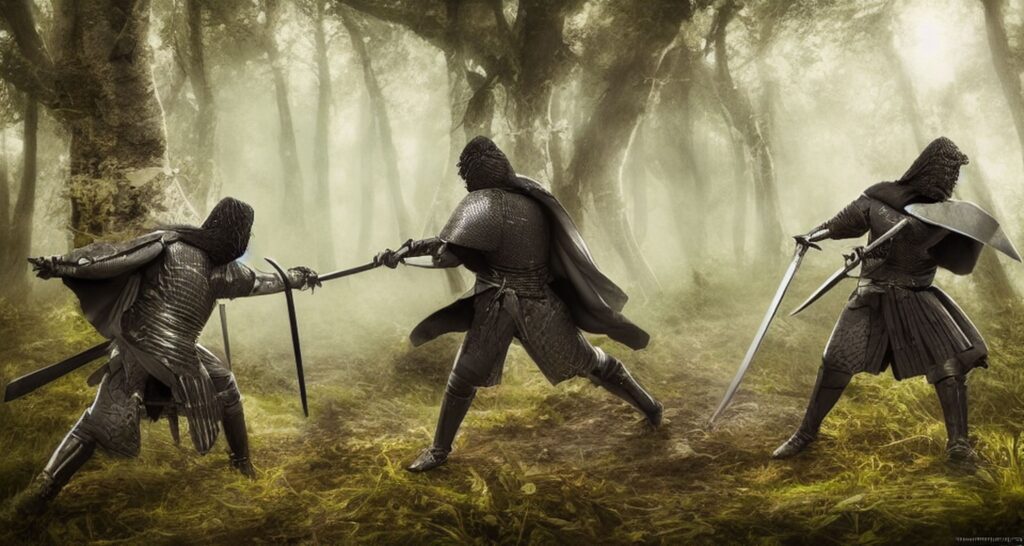
When we think of weapons in fantasy works, we often think of huge swords or magic bows wielded by heroes and heroines. However, a wide variety of weapons appear in fantasy works, and each has its own history and uses. In this article, we will discuss the various types of weapons that appear in fantasy works and how they make up the stories they tell.
1. The relationship between weapons and occupations in fantasy works
Fantasy works are known for their awesome weapons and vivid depictions of warring factions and global-scale conflicts. The choice and use of weapons often plays an important role in defining a character’s identity, including occupation and narrative perspective. Whether swords, bows, or staffs, these weapons can tell what kind of person a character is and what rank he or she belongs to in the overall story. For example, knights and infantrymen typically carry swords, archers carry bows, and powerful magic users carry large staffs or walking sticks. Outside of character classes, this pattern can also be seen in heroes. When we think of a great warrior fighting evil, we almost always imagine him or her with a sword in hand. Thus, the relationship between profession and weaponry unifies the narrative and makes it believable by providing consistency to the fantasy world, story, and characters. In this way, weapons provide another texture through which the audience can better understand the fantasy narrative. Thus, recognizing the relationship between occupation and choice of weapon in a fantasy work allows us to understand how stories are constructed, that is, how roles in each story lead to different actions, and ultimately allows us to look more closely at the meaning behind these stories This is the first step in the process of creating a more detailed view of the meaning behind these stories. In other words, it is important for those who study fantasy works to pay attention not only to what characters do with their weapons, but also to why they chose them, which adds another depth to the fantasy.
2. Types of melee weapons in fantasy works
When it comes to fantasy, there is no shortage of weapon choices. Swords, daggers, spears, maces, and other weapons for melee combat are staples of the genre. Swords, in particular, are the most recognizable of all fantasy weapons and are often used by warriors, knights, and heroes. Daggers also appear frequently in fantasy works. Daggers are sleek and lightweight, allowing them to quickly pierce opponents or dodge flying blows, and are used for both offensive and defensive purposes. Spears are effective against more than one opponent at a time, while maces are better suited for delivering powerful blows. Fantasy melee weapons come in many forms, from the iconic sword to smaller tools such as claws and war hammers. These weapons are advantageous in battles both large and small, and they are all useful items for the protagonists to use as they head into battle on their journeys.
The list includes sword, mace, axe, halberd, spear, knife, club, dagger, flail, sickle, warhammer staff, trident, whip, javelin, morningstar, warhammer, katar, falchion, rapier, scimitar, battle spear, nunchakus, kusarigama, etc.
3. Types of long-range weapons in fantasy works
In the world of fantasy, long-range weapons add a cool dynamic to the story. Whether it is an archer with a bow and arrow or a wizard fighting with magic spells, these weapons can transform the battlefield. Long-range weapons in fantasy works include bows and crossbows, throwing weapons such as shurikens and tomahawks, and magic spells cast by wizards. Bows are common in traditional fantasy, but recently crossbows have gained popularity due to their combination of power and range. Throwing weapons can add a unique element of surprise, as they can fire a barrage of bullets at an opponent unexpectedly if they can get close enough to their target. Finally, magic spells such as fireballs and lightning bolts can cover vast distances due to their sheer power. Whatever long-range weapon you choose in your fantasy world, make sure it has an exciting impact on both stories. What could be more thrilling than watching a wizard unleash a powerful fireball at a defenseless enemy? Whatever long-range weapon your character uses, it will bring color and life to your fantasy world.
Bows, crossbows, throwing knives, chakrams, shurikens, javelins, spears, slingshots, magic wands, walking sticks, bolas, blowguns, throwing axes, boomerangs, etc.

4. Excalibur, Anduril, Gungnir, etc. are some well-known examples of weapons from the world of fantasy.
It is only natural that in the world of fantasy there are legendary weapons that stand out from the rest. The “Excalibur,” for example, is a sword known for its unique shape and supernatural power. This weapon, said to have been forged in the Lake of Avalon, was famously wielded by King Arthur and has been a symbol of strength and courage for centuries. There is also Anduril, the Elven sword presented to Aragorn in “The Lord of the Rings. Able to cut through any enemy, Anduril helped Aragorn regain his kingdom, showing the strength of friendship. Then there is Gungnir, Odin’s spear. With this spiral weapon, Odin stands indomitable against the forces of evil, unleashing lightning and fire on his enemies. These three metals are deeply engraved in our minds through literature and mythology, and their presence gives us hope for victory against any enemy. Perhaps one day an Excalibur or Gungnir will be created for you. Even if it is not a magical sword like the ones in fantasy worlds, a metal sword will give you the courage and confidence to face any challenge. These iconic pieces are not just stories, but remind us to be serious when we face challenges.
5. Why are weapons important to fantasy heroes and heroines?
Weapons play an important role in fantasy works, often providing a physical representation of a character’s power. Weapons represent the hero or heroine’s ability to protect herself and her loved ones and often symbolize courage and strength. With a weapon, the character is in control of his or her life and can take on any difficult situation without being completely defenseless. Even if the weapon has magic or special abilities, it is ultimately an extension of the character’s own will to live. Weapons not only provide protection and independence, they also provide opportunities for personal growth. A character’s journey may be colored by switching from a short sword to a long one, learning a new way to swing an axe, or finding a new use for the bow he or she already has. When a hero or heroine picks up a weapon, it shows that she is ready to face any challenge with courage and determination.
6. How does the choice of weapon change the character that uses it?
The choice of weapon can have a profound effect on the character who uses it. From the sinister swords of heroes and villains to the nimble energy bows of science fiction adventures, weapons can have a variety of connotations. How a character interacts with a weapon and what motivations he or she has can reveal a lot about the kind of person he or she is. For example, characters who use weapons such as firearms tend to prefer practical solutions and understand the value of strength. Conversely, characters who use blades are more passionate and often prefer silence and speed over blunt weapons. Even a subtle choice such as a cane or magic wand can significantly alter the image of a character who overcomes adversity through the use of deep knowledge, strength, intelligence, and resourcefulness. In short, understanding how the choice of weapon affects the character setting can be very beneficial in developing memorable characters for the story.

Conclusion
It is clear that weapons are an important element in fantasy works. Weapons help define a character’s occupation and distinguish him or her from other characters in the story. The choice of weapon can also change the character’s personality and approach to conflict. Whether to protect or destroy, weapons play an important role in any fantasy work.
One of the most important elements of writing an engaging story is creating interesting characters and settings. If the main character is engaging, readers will be immediately drawn into the story, and an unpredictable setting can add depth to the story. To create impact with characters and settings, it is important to take the time to describe their motivations, backgrounds, and other details, as well as their physical space, in a way that is authentic and vivid. The complexity of both the characters and the world will keep readers engaged in the moment, unable to keep up with the development. Through effective writing mechanics and attention to detail, authors can bring characters and settings to life and transport readers to another world that they will never forget.






